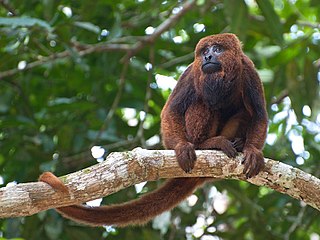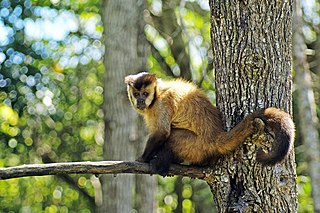
The Cebidae are one of the five families of New World monkeys now recognised. Extant members are the capuchin and squirrel monkeys. These species are found throughout tropical and subtropical South and Central America.

Night monkeys, also known as owl monkeys or douroucoulis, are nocturnal New World monkeys of the genus Aotus, the only member of the family Aotidae. The genus comprises eleven species which are found across Panama and much of South America in primary and secondary forests, tropical rainforests and cloud forests up to 2,400 metres (7,900 ft). Night monkeys have large eyes which improve their vision at night, while their ears are mostly hidden, giving them their name Aotus, meaning "earless".

Araucaria araucana, commonly called the monkey puzzle tree, monkey tail tree, piñonero, pewen or Chilean pine, is an evergreen tree growing to a trunk diameter of 1–1.5 m (3.3–4.9 ft) and a height of 30–40 m (98–131 ft). It is native to central and southern Chile and western Argentina. It is the hardiest species in the conifer genus Araucaria. Because of the prevalence of similar species in ancient prehistory, it is sometimes called an animate fossil. It is also the national tree of Chile. Its conservation status was changed to Endangered by the IUCN in 2013 due to the dwindling population caused by logging, forest fires, and grazing.

Howler monkeys are the most widespread primate genus in the Neotropics and are among the largest of the platyrrhines along with the muriquis (Brachyteles), the spider monkeys (Ateles) and woolly monkeys (Lagotrix). The monkeys are native to South and Central American forests. They are famous for their loud howls, which can be heard up to three miles away through dense rain forest. Fifteen species are recognized. Previously classified in the family Cebidae, they are now placed in the family Atelidae. They are primarily folivores but also significant frugivores, acting as seed dispersal agents through their digestive system and their locomotion. Threats include human predation, habitat destruction, illegal wildlife trade, and capture for pets or zoo animals.

Before humans went into space in the 1960s, several other animals were launched into space, including numerous other primates, so that scientists could investigate the biological effects of spaceflight. The United States launched flights containing primate passengers primarily between 1948 and 1961 with one flight in 1969 and one in 1985. France launched two monkey-carrying flights in 1967. The Soviet Union and Russia launched monkeys between 1983 and 1996. Most primates were anesthetized before lift-off.

Homunculus is an extinct genus of New World monkey that lived in Patagonia during the Miocene. Two species are known: Homunculus patagonicus and Homunculus vizcainoi, which are known from material found in the Santa Cruz Formation in the far south of Argentina.

Monkey is a common name that may refer to most mammals of the infraorder Simiiformes, also known as simians. Traditionally, all animals in the group now known as simians are counted as monkeys except the apes. Thus monkeys, in that sense, constitute an incomplete paraphyletic grouping; however, in the broader sense based on cladistics, apes (Hominoidea) are also included, making the terms monkeys and simians synonyms in regard to their scope.

The brown howler, also known as brown howler monkey, is a species of howler monkey, a type of New World monkey that lives in forests in south-eastern Brazil and far north-eastern Argentina (Misiones). It lives in groups of two to 11 individuals. Despite the name "brown howler", it is notably variable in colour, with some individuals appearing largely reddish-orange or black.

The black howler or black-and-gold howler, is among the largest New World monkeys and a member of the Alouatta genus. The black howler is distributed in areas of South America such as Paraguay, southern Brazil, eastern Bolivia, northern Argentina, and Uruguay. This species is sexually dimorphic, with adult males having entirely black fur and adult females and babies of both sexes having an overall golden colouring; which emphasizes black-and-gold in the name. The IUCN Red List has classed the black howler as Near Threatened as a result of a recent population reduction due to a variety of human-caused factors.

The black-capped squirrel monkey is a species of New-World monkey native to the upper Amazon basin in Bolivia, western Brazil and eastern Peru. They weigh between 365 and 1,135 g and measure, from the head to the base of the tail, between 225 and 370 mm. Black-capped squirrel monkeys are primarily tree-dwelling and are found in both native and plantation forests as well as some farmed areas near running water. Their diet is omnivorous and mostly consists of flowers, fruit, leaves, nuts, seeds, insects, arachnids, eggs and small vertebrates. They mostly live in female-dominated troops of around 40 to 75 monkeys, with males having been observed to disperse to live in all-male troops after reaching sexual maturation. Their current conservation status according to the IUCN is 'Least Concern'. The species belongs to the genus Saimiri and has two subspecies, S. b. boliviensis and S. b. peruviensis.

Azara's night monkey, also known as the southern night monkey, is a night monkey species from South America. It is found in Argentina, Bolivia, Brazil, Peru and Paraguay. The species is monogamous, with the males providing a large amount of parental care. It is named after Spanish naturalist Félix de Azara. Although primarily nocturnal, some populations of Azara's night monkey are unique among night monkeys in being active both day and night. The species is listed as Least Concern on the IUCN Red List.

Killikaike is an extinct genus of New World monkey. The genus includes one species, Killikaike blakei, that lived in Argentina during the Early Miocene.

Thoatherium is an extinct genus of litoptern mammals from the Early Miocene of Argentina. Fossils of the genus have been found in the Santa Cruz Formation in Argentina.

Notostylops is a genus of extinct South American ungulates from Eocene Argentina. Fossils of the genus have been found in the Sarmiento, Casamayor, Andesitas Huancache and Koluel Kaike Formations.

Tremacebus is an extinct genus of New World monkeys from the Early Miocene. The type species is T. harringtoni.
Protopithecus is an extinct genus of large New World monkey that lived during the Pleistocene. Fossils have been found in the Toca da Boa Vista cave of Brazil, as well as other locales in the country. Fossils of another large, but less robust ateline monkey, Caipora, were also discovered in Toca da Boa Vista.

Azaras's capuchin or hooded capuchin is a species of robust capuchin. It occurs in eastern Paraguay, southeastern Bolivia, northern Argentina, and Brazil, at Mato Grosso do Sul and Mato Grosso states, in Pantanal. Its habitat consists of subtropical, humid, semi-deciduous, gallery forests and forested regions of the Pantanals. Formerly, it was considered a subspecies of black-striped capuchin, according to Groves (2005) with the name Cebus libidinosus paraguayanus, but Silva Jr. (2001) considered it a separated species. They are considered as frugivores-insectivores which means that their diet mainly consists of a variety of fruits, seeds, arthropods, frogs, small mammals, etc.
Typotheriopsis is an extinct genus of Notoungulate belonging to the family Mesotheriidae, which included several small Meridiungulates specialized in digging. It is considered as the sister taxon of the clade including Mesotherium and Pseudotypotherium. Its fossils are known from the Chasicoan and the Huayquerian periods, notably among Late Miocene rocks from the Arroyo Chasicó Formation and the Cerro Azul Formation of Argentina.




















